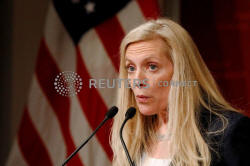Brainard: Fed should consider targeting longer rates in
a future downturn
 Send a link to a friend
Send a link to a friend
 [May 08, 2019]
RICHMOND, Va. (Reuters) - A top Federal
Reserve official said on Wednesday she wants to explore whether the
central bank, in a future downturn, should begin targeting explicit
levels for longer-term interest rates as a way to add more stimulus to
the economy. [May 08, 2019]
RICHMOND, Va. (Reuters) - A top Federal
Reserve official said on Wednesday she wants to explore whether the
central bank, in a future downturn, should begin targeting explicit
levels for longer-term interest rates as a way to add more stimulus to
the economy.
While not endorsing the use of such a strategy, Governor Lael Brainard
said she "would like to hear more about" it as the Fed continues a broad
review of how it conducts monetary policy.
If the short-term rates typically controlled by the Fed must again be
cut to zero, as they were in the 2007 to 2009 financial crisis and
recession, Brainard said the Fed under this method would use its power
to purchase securities in order to hit specified levels for one-year,
2-year and other interest rates.

"Once the short-term interest rates we traditionally target have hit
zero, we might turn to targeting slightly longer-term interest rates —
initially one-year interest rates, for example, and if more stimulus is
needed, perhaps moving out the curve to two-year rates," Brainard said
at an event with community leaders in Richmond. "Under this policy, the
Federal Reserve would stand ready to use its balance sheet to hit the
targeted interest rate."
The Fed used its power to influence longer-term interest rates by buying
Treasury bonds during the last crisis, as a way to add economic stimulus
once its policy rate hit the "zero lower bound."
But in that case it specified an amount of bonds to be purchased each
month. Specifying longer term rates, by contrast, would be a new venture
for the Fed, giving businesses and investors an explicit sense of where
borrowing costs would be set. It is similar to the "yield curve control"
policy used by the Bank of Japan.
[to top of second column] |

Federal Reserve Board Governor Lael Brainard speaks at the John F.
Kennedy School of Government at Harvard University in Cambridge,
Massachusetts, U.S., March 1, 2017. REUTERS/Brian Snyder/File Photo

Brainard's call to explore that option showed how broad the Fed's
current review of its operating tools and strategies has become.
Still, Brainard cautioned that all of the ideas under debate share both
strengths and potential weaknesses.
One often mentioned idea of using periods of higher inflation to "make
up" for periods when inflation is weak, as it has been for the past
decades, suffers from the risk that central bankers would - in the face
of a faster pace of price increases - lose their nerve and not follow
through during the make up phase.
"While such approaches sound quite appealing on their face, they have
not yet been implemented in practice. There is some skepticism that a
central bank would in fact prove able to support above-target inflation
over a sustained period without becoming concerned that inflation might
accelerate," Brainard said.
(Reporting by Howard Schneider; Editing by Chizu Nomiyama)
[© 2019 Thomson Reuters. All rights
reserved.] Copyright 2019 Reuters. All rights reserved. This material may not be published,
broadcast, rewritten or redistributed.
Thompson Reuters is solely responsible for this content.
 |